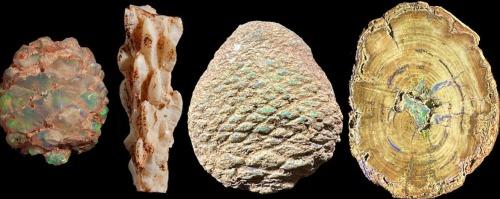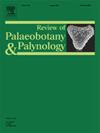An opalised mid-Cretaceous flora from the Griman Creek Formation at lightning ridge, eastern Australia
IF 1.7
3区 地球科学
Q2 PALEONTOLOGY
引用次数: 0
Abstract
A rich Albian–Cenomanian opalised plant fossil assemblage is described from the Griman Creek Formation at Lightning Ridge in the Surat Basin, northern New South Wales, Australia. The fossils are preserved predominantly as opal casts that retain few anatomical or micromorphological epidermal details. For this reason, most fossils are difficult to assign with higher taxonomic resolution than to plant families. Nevertheless, the assemblage appears to be dominated by scale-leafed cupressacean foliage and cones, with lesser proportions of araucariacean, podocarp and possibly cheirolepidacean conifers that likely constituted the middle and upper storeys of the palaeovegetation. Understorey ferns and sphenopsids are sparse. Angiosperms are notably absent but unusual pyramidal seeds may indicate the presence of the Bennettitales-Erdtmannithecales-Gnetales group in the palaeoflora. The plant fossils are co-preserved with a broad range of terrestrial and aquatic vertebrate and invertebrate remains that collectively attest to a coastal plain setting fringing the Surat Basin embayment of the epeiric ‘Eromanga Sea’, which flooded the epicratonic Great Artesian Basin complex during the Early Cretaceous. Several plant groups are shared with broadly coeval fossil floras from eastern Australia and New Zealand reflecting a fairly typical mid-Cretaceous middle- to high-latitude austral flora, but the Lightning Ridge assemblage notably lacks delicate and broad-leafed taxa, possibly owing to preservational and sampling biases. We highlight opportunities for the study of opalised plant fossils from various other assemblages in eastern Australia and note that analysis of future collections of carefully extracted specimens from the Lightning Ridge deposits offer the potential to yield micromorphological details.

澳大利亚东部闪电岭格里曼溪组白垩纪中期的乳白色植物群
澳大利亚新南威尔士州北部苏拉特盆地闪电岭的格里曼溪组描述了一个丰富的阿尔及利亚-塞诺曼尼亚乳白色植物化石组合。化石主要以蛋白石的形式保存下来,保留了很少的解剖或微形态表皮细节。由于这个原因,大多数化石很难以比植物科更高的分类学分辨率来确定。尽管如此,该组合似乎以鳞片叶的柏科植物的叶子和球果为主,较少比例的araucariacaceae, podocarp和可能的chrolepidacaceae针叶树可能构成了古植被的中上层。下层蕨类植物和桫椤稀疏。被子植物明显缺失,但不寻常的锥体种子可能表明古植物区系中存在bennettitales - erdtmannicales - gnetales类群。这些植物化石与广泛的陆生、水生脊椎动物和无脊椎动物遗骸共同保存在一起,共同证明了在“Eromanga海”的表层苏拉特盆地(Surat Basin)边缘的沿海平原环境,该盆地在早白垩纪淹没了大自流盆地复合体。有几个植物类群与来自澳大利亚东部和新西兰的大致相同的化石植物群共享,反映了一个相当典型的白垩纪中期中至高纬度的南方植物群,但闪电岭组合明显缺乏精致和阔叶的分类群,可能是由于保存和采样的偏差。我们强调了研究澳大利亚东部各种其他组合的蛋白化植物化石的机会,并指出,对未来从闪电岭沉积物中精心提取的标本进行分析,有可能产生微观形态细节。
本文章由计算机程序翻译,如有差异,请以英文原文为准。
求助全文
约1分钟内获得全文
求助全文
来源期刊
CiteScore
3.50
自引率
21.10%
发文量
149
审稿时长
6 months
期刊介绍:
The Review of Palaeobotany and Palynology is an international journal for articles in all fields of palaeobotany and palynology dealing with all groups, ranging from marine palynomorphs to higher land plants. Original contributions and comprehensive review papers should appeal to an international audience. Typical topics include but are not restricted to systematics, evolution, palaeobiology, palaeoecology, biostratigraphy, biochronology, palaeoclimatology, paleogeography, taphonomy, palaeoenvironmental reconstructions, vegetation history, and practical applications of palaeobotany and palynology, e.g. in coal and petroleum geology and archaeology. The journal especially encourages the publication of articles in which palaeobotany and palynology are applied for solving fundamental geological and biological problems as well as innovative and interdisciplinary approaches.

 求助内容:
求助内容: 应助结果提醒方式:
应助结果提醒方式:


